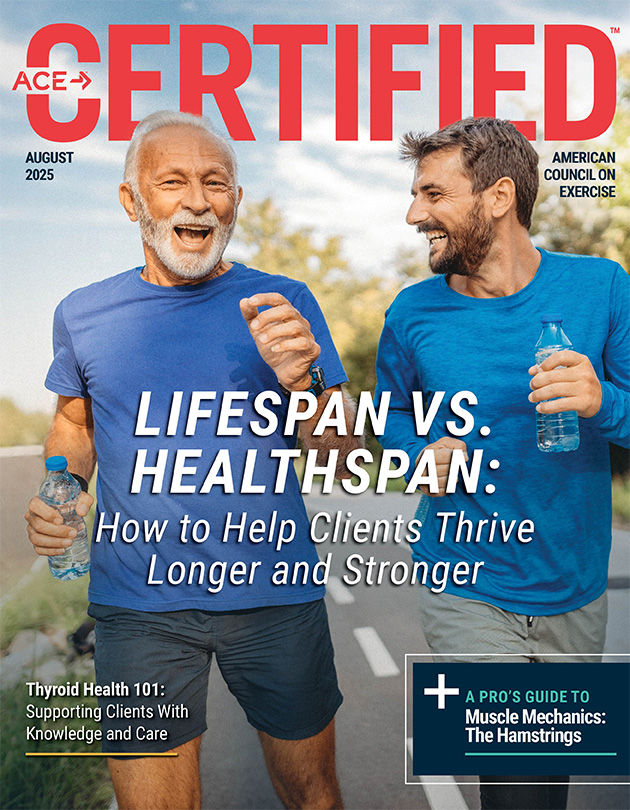
Changing Food Habits—One Click at a Time

As any health coach or exercise professional knows, the choices clients make outside of the gym—particularly when it comes to food—have a profound impact on their progress. While exercise is a key part of the wellness equation, diet plays an equally important role. A new study from Duke-NUS Medical School highlights how subtle design features in online grocery shopping platforms can guide individuals toward healthier decisions, making it easier to support clients in improving diet quality through everyday behaviors.
A Digital Toolkit for Healthier Choices
Published in the American Journal of Preventive Medicine, the study evaluated the impact of a multicomponent digital intervention on the nutritional quality of food purchases made through an online grocery platform. The researchers set out to answer this question: Can simple, scalable online tools be used to improve food choices at the point of purchase? Their findings suggest that the answer is a resounding yes.
Using a randomized controlled trial (considered the gold standard in research studies), the researchers divided participants into two groups. Both used a simulated grocery store called NUSMart, but only one group had access to a version enhanced with a set of digital tools. These features included traffic-light-style front-of-package nutrition labels, real-time feedback on cart contents, a product sorting mechanism that displayed the healthiest foods first, and a prompt offering healthier substitutions for selected items. Over the course of three shopping trips, those in the intervention group consistently purchased food that was higher in nutritional quality and lower in calories, saturated fat, total fat, sugar and sodium.
“As online grocery shopping is rapidly gaining ground, we wanted to see if we could design low-cost, scalable online tools that could be used to nudge consumers toward healthier choices at the point of purchase,” explains Assistant Professor Soye Shin, lead author of the study. “These results show the potential of these tools to improve diet and health outcomes.”
Results That Matter
The improvements observed in the intervention group were notable. Participants shifted their average grocery cart’s nutritional quality from a Nutri-Score grade of C to B. The Nutri-Score system, widely used in parts of Europe and adapted in this study, assigns letter grades to foods based on the balance of beneficial and detrimental nutrients. A four-point improvement on this scale, the researchers noted, represented a meaningful difference in diet quality. Additionally, the intervention led to modest reductions in calorie content (by nearly 13 kilocalories per serving), saturated fat (by 0.85 grams), total fat (by 1.21 grams), sugar (by 0.82 grams), and sodium (by more than 150 milligrams) per serving.
What sets this study apart from earlier efforts is the integration of multiple behavioral strategies. While prior research has shown that front-of-package labels can have a modest effect on purchasing decisions, this study found that combining those labels with other digital nudges—such as reorganizing how products are displayed and offering real-time nutritional feedback—resulted in a significantly larger effect. Not only were the improvements immediate, but they persisted across all three shopping sessions, suggesting the potential for long-term habit change.
Professor Eric Finkelstein, senior author of the study, underscored the practical implications of these findings. “These results are encouraging, but the next step is to work with retailers to incorporate these features into existing online stores. Only then will the full value of this approach be realized.”
Implications for Coaching and Client Support
This research carries direct relevance for those working in the health and fitness industry, particularly coaches and trainers who support clients in building sustainable wellness habits. One of the key takeaways is the importance of helping your clients create environments that make healthier choices easier. Just as you may design workout spaces and sessions to reduce friction and encourage participation, you can also guide your clients in designing a healthier food environment—both digitally and physically.
For example, encourage your clients to approach grocery shopping with more intention. Instead of letting convenience or habit drive their decisions, clients can be coached to view shopping as an extension of their wellness practice. Although not all platforms currently offer tools like real-time cart feedback or automatic healthy substitutions, the core behaviors promoted in the study—such as reading nutrition labels, prioritizing nutrient-dense foods and actively comparing alternatives—can be cultivated through coaching conversations and personalized strategies.
Helping clients understand how to evaluate their grocery cart as a whole, rather than focusing on individual items, can also support more balanced nutrition. Instead of encouraging clients to eliminate favorite foods entirely, invite them to reflect on the overall quality of their cart and consider one or two simple substitutions each week. These small, achievable changes—like swapping a sugar-laden cereal for a higher-fiber alternative or choosing a lower-sodium soup—can accumulate over time and lead to measurable improvements in health.
Guiding Lasting Behavior Change
The concept of behavioral nudges also reinforces a foundational principle in health coaching: people are more likely to follow through with healthy behaviors when those behaviors feel manageable and integrated into their daily routine. This study demonstrates that clients don’t necessarily need sweeping overhauls to make progress. Instead, they benefit most from smart, well-timed cues that guide decisions without requiring excessive willpower or effort.
As a health and exercise professional, this presents an opportunity for you to collaborate with clients in developing simple systems that support their goals. This might include setting up grocery lists based on meals for the week, reviewing online cart screenshots during sessions or even exploring grocery delivery options that make healthy food more accessible. With more clients relying on digital platforms to manage their shopping, integrating these tools into the coaching process can be an effective way to help your clients achieve their nutrition-related goals.
Looking ahead, the Duke-NUS researchers plan to expand their investigation to explore whether these digital interventions can benefit individuals with lower socioeconomic status or limited nutrition knowledge. If the results hold true across more diverse populations, the public health implications could be significant. Professor Patrick Tan, Senior Vice-Dean for Research at Duke-NUS, notes that the study reflects “how smart, evidence-based interventions—when applied at the right moment—can empower people to make better everyday choices for their health.” He adds that such approaches not only improve individual behaviors but have the potential to elevate population-level health outcomes as well.
A Call to Action for Health and Exercise Professionals
Ultimately, the findings of this study remind us that creating meaningful change often starts with the environment in which choices are made. For health and exercise professionals, the message is clear: By helping clients navigate their food environments—whether in-person or online—you can support more informed decisions, foster sustainable behavior change and contribute to a broader culture of wellness.
By bringing awareness to the tools available in the online shopping space and encouraging their use, you can help bridge the gap between intention and action in nutrition. These digital nudges are more than technical features—they represent a powerful opportunity to influence real-world health behaviors. And in a world where convenience often trumps intention, even small nudges can make a big difference.

More Articles
- Certified™: August 2025
Why Healthspan Matters More Than Lifespan—And How Exercise Can Help
Contributor
- Certified™: August 2025
Thyroid Health 101: Supporting Clients With Knowledge and Care
Contributor
- Certified™: August 2025
Ask ACE: How to Integrate Blood Flow Restriction Training Into Your Exercise Programming
Contributor
- Certified™: August 2025
Calorie Restriction and Mental Health: What the Data Says
Contributor
- Certified™: August 2025
A Pro’s Guide to Muscle Mechanics: The Hamstrings
Health and Fitness Expert




 by
by 

